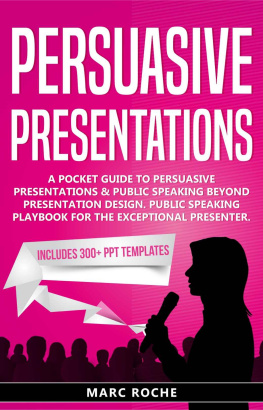Contents
Introduction
What makes a good Hollywood movie? Exactly the same principles that make a great keynote speech, executive presentation, or important business conversation.
Why? Imagine that you have unlimited resources to create a speech that will make you the hottest commodity on the market, inspire your colleagues, or motivate your staff. Where would you go to get the best, highest-priced writers and directors in the world?
Hollywood!
The good news is that you probably dont need unlimited resources to hire an Oscar winning writer and director. Just learn to adapt basic Hollywood techniques to increase the impact of your keynote speeches, business presentations, and persuasive sales conversations.
Embrace the Creative Process
Our first step is to look at the creative process. Comedian George Carlin said, Creating a great speech or comedy routine is more like going on a field trip than working in a laboratory. He meant that the creative process isnt neat and tidy. Its rambling and messy. To create your masterpiece of a presentation, get comfortable with exploring and experimenting. Forget the PowerPoint. Thats tidy. With a yellow pad, flip chart, or whiteboard, start by listing or mind mapping what content could go in your presentation. You want stories, examples, quotes, statistics, your corporate message, and client successes. Then take the results of the field trip into the laboratory. Thats when you organize your presentation into a conversational and logical structure. One of the biggest mistakes my executive clients and sales teams make is to have someone else create the PowerPoint before they craft their speech or presentation.
If you had just one sentence rather than forty-five minutes, what would you say? Thats what I ask my executive coaching clients. Their reply often becomes their opening line. A particularly compelling one is:
Every [describe who is the audience] can [name the subject of your talk].
Youve got their attention and focused them on your topic. But there are dozens of others.
One of my favorite clients, Bernard, answered, This is a brand new company. Then write this down, I told him. Your opening line is, Welcome to a brand new company.
Next we needed to add the stories, characters, and dialogue, plus the So what? that would make a memorable and persuasive speech. So I asked Bernard a series of questions:
Who decided on this corporate direction, you or someone else?
In the Board meeting, who said what to whom?
At what age did your realize the importance of strategy?
How do you explain corporate citizenship to your children?
What do you want to challenge your sales professionals to do?
What can they expect from you?
What will be better in their lives and careers?
How will this strategy position your company in the industry?
And, most important:
What do you want to be different after your presentation?
My approach is to ask questions that lead the presenters to tell me their stories and experiences. It may take a little digging, but invariably we come up with compelling material. Most of these clients ask, Does the audience really what to hear these stories? YES! It is essential that your audience sees the person behind the position. We are more likely to be motivated when we can see the life lessons beyond the corporate message.
Choose a Structure
You dont have to decide on your structure before you begin assembling your material. However, it will probably end up falling into one of these familiar Hollywood formats: start at the beginning, start in the middle, or start at the end.
Start at the beginning. This is the age-old Once upon a time technique, just like in every childs nursery story. It works for children, movies, and executive presentations. We learn who our story is about, and we find a way to emotionally bond. Perhaps we relate, or are curious, or just interested to know what will happen next. To keep the audience interested, we have to develop characters to drive the story forward. They are on a quest or heros journey that is told in chronological order. This is the oldest storytelling technique known to mankind. Start at the beginning and tell your story or talk about your experience. Just as in many movies, you introduce the characters, describe the situation, and then keep going. The event may have lasted a few minutes or a generation, but it is related in the order it happened.
Start in the middle. The Hollywood name for this is In medias res, Latin for in the middle of things. You start right in the middle of the action, then go back to show how this happened. Rambo II opens with Sylvester Stallone about to fightin a monastery! Who and why? Youre eager to know. Sunset Boulevard starts with a dead body in a swimming pool. What happened? The dead body then tells us how he got there and what happened afterwards. Both these films turn into flashbacks, revealing what led up to this point, before showing us what happened next.
My friend, Scott Halford, was going to make a speech about his career. When I was a boy, he told me, I was always interested in films. My parents encouraged me, and I went to screen school, and I became a documentary filmmaker. So far, this is a once upon a time tale. But would audiences immediately relate to this curriculum vita version of his life? Then he told me something that made me sit up in my chair. We had an interesting assignment, he said, where we went into death row. I actually spent a week in solitary confinement and ended up sitting in the electric chair.
Patricia, how would you tell this story? he asked when hed finished describing his career.
Alfred Hitchcock said, A movie is like life with all the dull parts left out, I told Scott. Leave out everything that doesnt add to it. And start in the middle with the story about sitting in the electric chair. Here is how Scott began his presentation:
It was the scariest moment of my life. My head was shaved. The wet sponge was taped to my forehead. I was strapped into Sparky, the electric chair.
An opening like that should get any audiences attention! What would they be thinking? Probably Oh my god, what did he do? He looks so respectable. How did he live to be here? Now Scott had the audience intrigued. Then he jumped back to the beginning of the story as he had told it to me. When I was a young man, I was always interested in movies. I went to film school. My parents encouraged me. I became a documentary filmmaker and went on to and he described his various projects including the death row assignment. How much more intriguing because he started in the middle.
Start with the endingand beyond. Some movies open with the very end of the story, then flashback to show what happened to get the characters there. For speeches, this means you start with the results achieved and then go back to show how. Or you could project the audience into the future. You might begin your presentation with, Imagine its April 10th next year. Then paint a picture of what that audience could have achieved. Describe how their choices can make that goal a reality and the thrill of their achievement. Add, Will that be the reality? It all depends on what actions you take after listening to the message you hear on April 10th (this year).
There are other formats, of course, but keep these three basic ones in mind if you arent sure how to begin organizing your material.
Open with a Great Story
Screenwriting teacher Robert McKee says, Stories are the creative conversion of life itself into a more powerful, clearer, more meaningful experience. We all love stories, and, whenever we hear one, we subconsciously feel it is a treat.
Stories are what Hollywood is all about; powerful, unforgettable stories that make you and your message memorable. With your business stories, identify your main theme, premise or purposeyour plotand any subplots. For example, I coached John, a retail executive for a large clothing chain. A week after a big promotion, John was invited to speak to 500 young store managers at the company sales meeting. His challenge was to inspire the managers to embrace a program to get their employees to contribute money-saving ideas. (Those managers were probably already groaning and rolling their eyes at the difficulty of such an assignment.) As I pointed out, Johns text was the employee program, but he had a vital subtext: Now you can see why I deserved this promotion.
Next page







